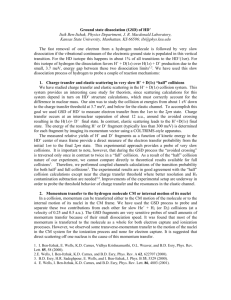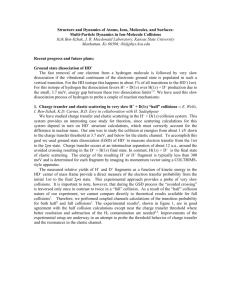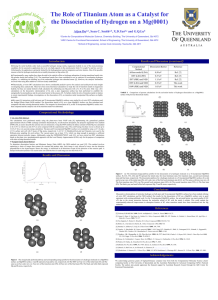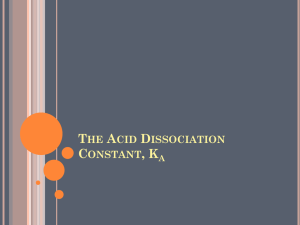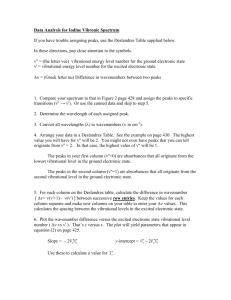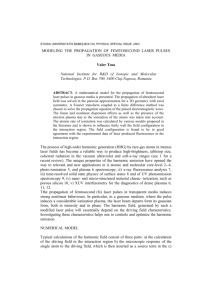Word - James R. Macdonald Laboratory
advertisement
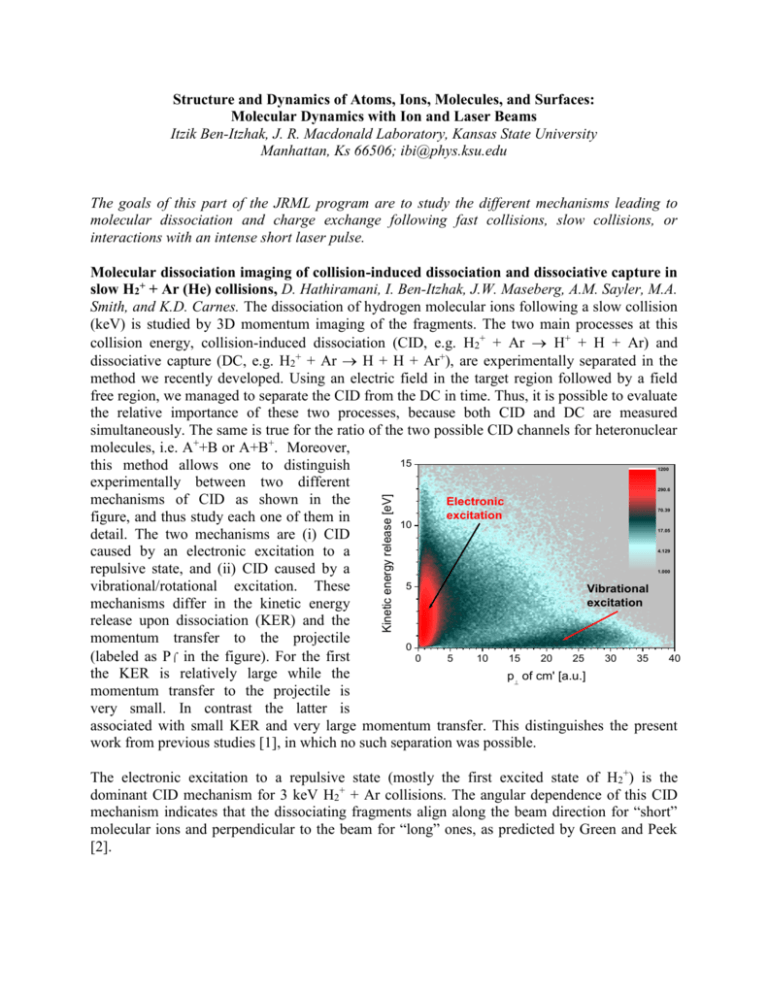
Structure and Dynamics of Atoms, Ions, Molecules, and Surfaces: Molecular Dynamics with Ion and Laser Beams Itzik Ben-Itzhak, J. R. Macdonald Laboratory, Kansas State University Manhattan, Ks 66506; ibi@phys.ksu.edu The goals of this part of the JRML program are to study the different mechanisms leading to molecular dissociation and charge exchange following fast collisions, slow collisions, or interactions with an intense short laser pulse. Molecular dissociation imaging of collision-induced dissociation and dissociative capture in slow H2+ + Ar (He) collisions, D. Hathiramani, I. Ben-Itzhak, J.W. Maseberg, A.M. Sayler, M.A. Smith, and K.D. Carnes. The dissociation of hydrogen molecular ions following a slow collision (keV) is studied by 3D momentum imaging of the fragments. The two main processes at this collision energy, collision-induced dissociation (CID, e.g. H2+ + Ar H+ + H + Ar) and dissociative capture (DC, e.g. H2+ + Ar H + H + Ar+), are experimentally separated in the method we recently developed. Using an electric field in the target region followed by a field free region, we managed to separate the CID from the DC in time. Thus, it is possible to evaluate the relative importance of these two processes, because both CID and DC are measured simultaneously. The same is true for the ratio of the two possible CID channels for heteronuclear molecules, i.e. A++B or A+B+. Moreover, 15 this method allows one to distinguish experimentally between two different mechanisms of CID as shown in the Electronic excitation figure, and thus study each one of them in 10 detail. The two mechanisms are (i) CID caused by an electronic excitation to a repulsive state, and (ii) CID caused by a 5 vibrational/rotational excitation. These Vibrational excitation mechanisms differ in the kinetic energy release upon dissociation (KER) and the momentum transfer to the projectile 0 (labeled as P in the figure). For the first 0 5 10 15 20 25 30 35 40 the KER is relatively large while the p of cm' [a.u.] momentum transfer to the projectile is very small. In contrast the latter is associated with small KER and very large momentum transfer. This distinguishes the present work from previous studies [1], in which no such separation was possible. 1200 Kinetic energy release [eV] 290.6 70.39 17.05 4.129 1.000 The electronic excitation to a repulsive state (mostly the first excited state of H2+) is the dominant CID mechanism for 3 keV H2+ + Ar collisions. The angular dependence of this CID mechanism indicates that the dissociating fragments align along the beam direction for “short” molecular ions and perpendicular to the beam for “long” ones, as predicted by Green and Peek [2]. The vibrational/rotational dissociation mechanism shows very strong alignment effects, as shown in the figure. First, molecular ions aligned perpendicular to the beam velocity (i.e. θ = 90°) are much more - Projection Fit : F() = Cos () n = 3.88 ± 0.18 likely to dissociate by this mechanism. Fit : F() = Cos () Second, the dissociation velocity is n = 16.5 ± 1.2 preferentially aligned along the Counts momentum transfer (i.e. α = 0°, where 5.00 α is the angle between the dissociation 0.5 6.72 velocity in the x-y plane and the direction of the transverse momentum 9.04 0.0 transfer). The angular distribution in θ is much narrower than in α, as 12.2 indicated by the much higher power of -0.5 n the cos fit to the data. Further analysis Cos() 16.4 Projection of the DC and CID processes as well as model calculations of the vibrational 22.0 -80 -60 -40 -20 0 20 40 60 80 (degrees) CID mechanism are underway. n 1 n 2 Cos() 0.5 0.0 -0.5 Recently we have conducted studies of CID of HD+ in similar collisions in search of the isotopic effects observed previously for this molecular ion [see, for example, Refs. 3,4], namely, that the dissociation into H + D+ was favored over H+ + D. Preliminary results indicate that such effects, if they exist, are much smaller than those reported in previous work. These results will be presented as an invited talk in the CAARI 2002 meeting. Future plans: Systematic studies of DC and CID caused by either electronic or vibrational excitation will be conducted focusing on the effect of the target species and the collision energy. Our preliminary results indicate significant differences in vibrational CID between Ar and He targets. Furthermore, we plan to investigate both these processes for a few additional simple molecular ions, such as HeH+, He2+ and H3+. While conducting these studies on the existing system, an improved setup, which includes a cold jet target, will be assembled and tested. This will enable the simultaneous measurement of the recoil ion momentum for DC reactions, thus providing kinematically complete information about the process. 1. J. Los and T.R. Govers, in Collision Spectroscopy (ed. R.G. Cooks, Plenum Press, NY 1978) p-289 2. T.A. Green and J.M. Peek, Phys. Rev. 183, 166 (1969) 3. T.A. Lehman et al. Int. J. Mass Spectrom. Ion Proc. 69, 85 (1986) 4. R.W. Rozett and W.S. Koski, J. Chem. Phys. 49, 2691 (1968) Isotopic effects and asymmetries in bond-rearrangement and bond-breaking processes in water ionized by fast proton impact. A.M. Sayler, Z.S. Casey, J.W. Maseberg, D. Hathiramani, K.D. Carnes, B.D. Esry, and I. Ben-Itzhak. Studies of ionization and fragmentation of water molecules by fast protons and highly charged ions have revealed an interesting isotopic preference for H-H bond rearrangement. Specifically, the dissociation of H2O+H2++O is about twice as likely as D2O+D2++O, with HDO+HD++O in between. Further investigations of this isotopic effect lead us to discover a similar isotopic effect following double ionization of water, i.e. in H2O2+H2++O+, although these results are preliminary. In addition, we have observed large asymmetries in bond breaking in the HDO isotope. For example, HDO+H++OD is more likely than HDO+D++OH by about a factor of 1.5, suggesting that it is easier to break the O-H bond than the O-D bond. This preference is even larger in the dissociation of HDO2+. Calculations are underway to determine the relative production rates for the different isotopes from the overlap of the initial and final vibrational wave functions and the time evolution of the final wave function. In addition, we determined the relative cross sections of all dissociation channels including H+ + H+ + O which typically are not measured by TOF techniques. These results were presented by Max Sayler as an invited talk in the undergraduate research session of DAMOP 2002. Future plans: The isotopic enhancement in the H2O2+H2++O+ dissociative double ionization channel requires further investigation to determine if it is similar in magnitude to that found in single ionization. We also intend to study ionization and fragmentation of water by fast highly charged ions and compare them to fast proton impact. High intensity laser interactions 1. Evidence for pondermotive-gradient field-ionization in an intense focused laser beam, E. Wells (UVA), I. Ben-Itzhak, and R.R. Jones (UVA). We have measured the Rydberg ion population produced during intense laser ionization in Xe, Kr, and Ar. The branching ratio for production of Rydberg ions, A(q-1)+*, to ions Aq+ has been measured as a function of laser intensity and polarization. Using 100 fs, 790 nm laser pulses, singly and double charged Rydberg ions are observed in Xe, but in Kr and Ar only singly charged Rydberg ions are seen. Model calculations of ionization by the gradient of the pondermotive potential (Up) of the focused laser beam suggest that the Rydberg population is inversely proportional to the ionization potential of the ion species. These calculations are in agreement with our data except for the Xe2+*/Xe3+ ratio, which is anomalously large, approximately a factor of two higher than the Xe+*/Xe2+ ratio. 2. Photo ionization and photo dissociation of H2+ by an intense short pulse laser, I. BenItzhak, J.W. Maseberg, A.M. Sayler, M.A. Smith K.D. Carnes, Z. Chang, C. Fehrenbach, and C.L. Cocke. We have recently begun measurements of ionization and dissociation of a few keV H2+ beam crossed by an intense short-pulse laser beam using 3D molecular dissociation imaging on a newly installed apparatus employing techniques similar to those described in 3.1. Only a couple of previous measurements have been reported so far [1,2]. Future plans: We plan to measure the dependence of ionization and dissociation of H2+, and other simple molecular ions, on the duration of the intense laser pulse. It has been predicted that the ratio of ionization to dissociation will change with increasing number of laser cycles, i.e. pulse width [3]. 1. K. Sändig, H. Figger, and T.W. Hänsch, Phys. Rev. Lett. 85, 4876 (2000) 2. I.D. Williams et al. J. Phys. B 33, 2743 (2000) 3. Kulander et al. Phys. Rev. A 53, 2562 (1996) Formation and decay mechanisms of 4He22+ dimers, I. Ben-Itzhak, and A. Bar-David, I. Gertner, and B. Rosner (Technion). We have measured the decay rate and kinetic energy release upon dissociation of 4He22+ dimers formed in He2+ +Ar charge stripping collisions. The measured mean lifetime indicates that He2+ molecular ions are preferentially formed with high angular momentum, i.e. high l values, as suggested by our previous measurements of 3He4He2+. For the 4 He22+ isotope low l-states as well as high l-states are within the high sensitivity range of our experimental setup. Publications: 1. “A comparative study of the ground state dissociation of H2+ and D2+ induced by ionizing and electron capture collisions with He+ at velocities of 0.25 and 0.5 a.u.”, W. Wolff, I. Ben-Itzhak, H.E. Wolf, C.L. Cocke, M.A. Abdallah, and M. Stöckli, , Phys. Rev. A 65, 042710 (2002). 2. “A kinematically complete charge exchange experiment in the Cs+ + Rb collision system using a MOT target”, X. Flechard, H. Nguyen, E. Wells, I. Ben-Itzhak, and B.D. DePaola, Phys. Rev. Lett. 87, 123203 (2001). 3. “Charge exchange and elastic scattering in very slow H+ + D(1s) “half” collisions”, E. Wells, I. Ben-Itzhak, K.D. Carnes, and B.D. Esry, Phys. Rev. Lett. 86, 4803 (2001). 4. “Transfer Ionization to Single Capture Ratio for Fast Multiply Charged Ions on He”, R. Ünal, P. Richard, H. Aliabadi, H. Tawara, C.L. Cocke, I. Ben-Itzhak, M.J. Singh, and A.T. Hasan, Application of Accelerators in Research and Industry, edited by J.L. Duggan and I.L. Morgan (AIP press, New York 2001), p-36. 5. “Velocity Dependence of Electron Removal and Fragmentation of Water Molecules Caused by Fast Proton Impact”, A.M. Sayler, E. Wells, K.D. Carnes, and I. Ben-Itzhak, Application of Accelerators in Research and Industry, edited by J.L. Duggan and I.L. Morgan (AIP press, New York 2001), p-33. 6. “Double and Single Ionization of hydrogen molecules by fast proton impact”, I. BenItzhak, E. Wells, D. Studanski, Vidhya Krishnamurthi, K.D. Carnes, and H. Knudsen, J. Phys. B 34, 1143 (2001). 7. "Measurements of the mean lifetime and kinetic energy release of metastable CO 2+,” J.P. Bouhnik, I. Gertner, B. Rosner, Z. Amitay, O. Heber, D. Zajfman, E.Y. Sidky, and I. Ben-Itzhak, Phys. Rev. A 63, 032509 (2001). 8. “Charge exchange in slow H+ + D(1s) collisions”, B.D. Esry, H.R. Sadeghpour, E. Wells, and I. Ben-Itzhak J. Phys. B 33, 5329 (2000). 9. “Asymmetric branching ratio for the dissociation of HD+(1s)”, E. Wells, I. Ben-Itzhak, K.D. Carnes, and B.D. Esry, Phys. Rev. A 62, 622707 (2000). 10. "Symmetry breakdown in ground state dissociation of HD+,” I. Ben-Itzhak, E. Wells, K.D. Carnes, Vidhya Krishnamurthi, O.L. Weaver, and B.D. Esry, Phys. Rev. Lett. 85, 58 (2000). 11. “The “Foil-Mesh” method for mean lifetime measurements of long lived molecular ions”, A. Bar-David, I. Ben-Itzhak, J.P. Bouhnik, I. Gertner, Y. Levy, and B. Rosner, Nucl. Instrum. Method B 160, 182 (2000).
